How To Find Profitable Keywords (Works For Every Niche)
Georgi Todorov
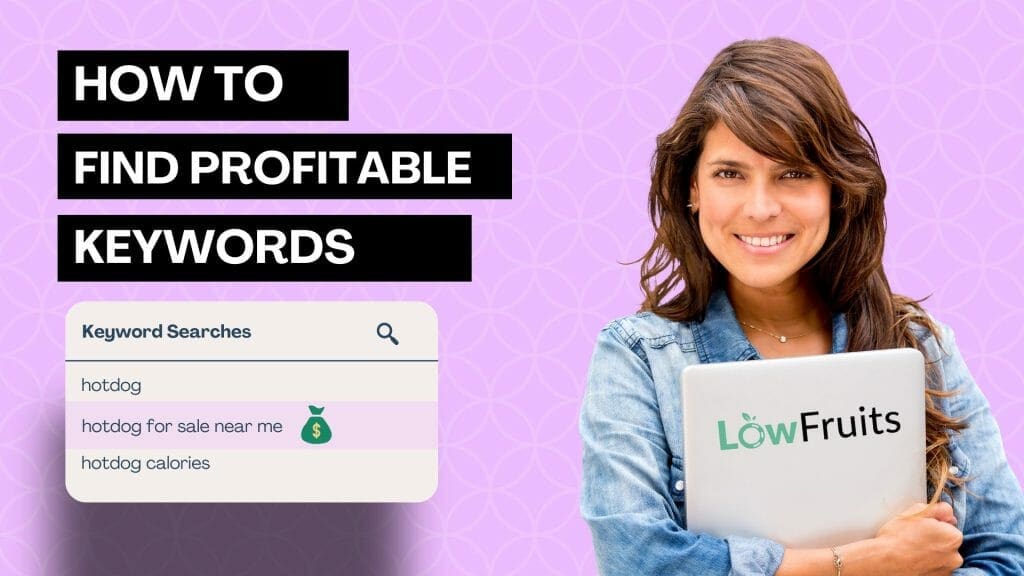
The aim of keyword research is to discover article and product page targets, but the reality is that SEOs often generate numerous keywords that can be problematic.
Sometimes keywords are either:
- Unrealistic to rank for
- Do not have any revenue potential (e.g., going after ”how to tie your shoes” with your shoe company)
- There is no clear way of prioritising them
To monetize your blog, target “money keywords.” This article will outline the standard keyword research process step-by-step and offer insights on conducting research from your customers and prospects.
What are Money Keywords?
To start off, what are money keywords exactly?
These are keywords that you could rank for, even though they do not necessarily have a lot of search demand. It is their commercial intent that makes them valuable assets.
Money keywords look different in different niches and industries, but here are a few examples:
- B2C SEO – ”pizza restaurants near me”; ”affordable pizza restaurant”; ”pizza restaurants in london”; ”pizza restaurant pizza takeaway”; ”pizza takeaway under $20”
- B2B SEO – ”best tools for community management”; ”alternative to X community management tool”; ”how to choose a community tool”
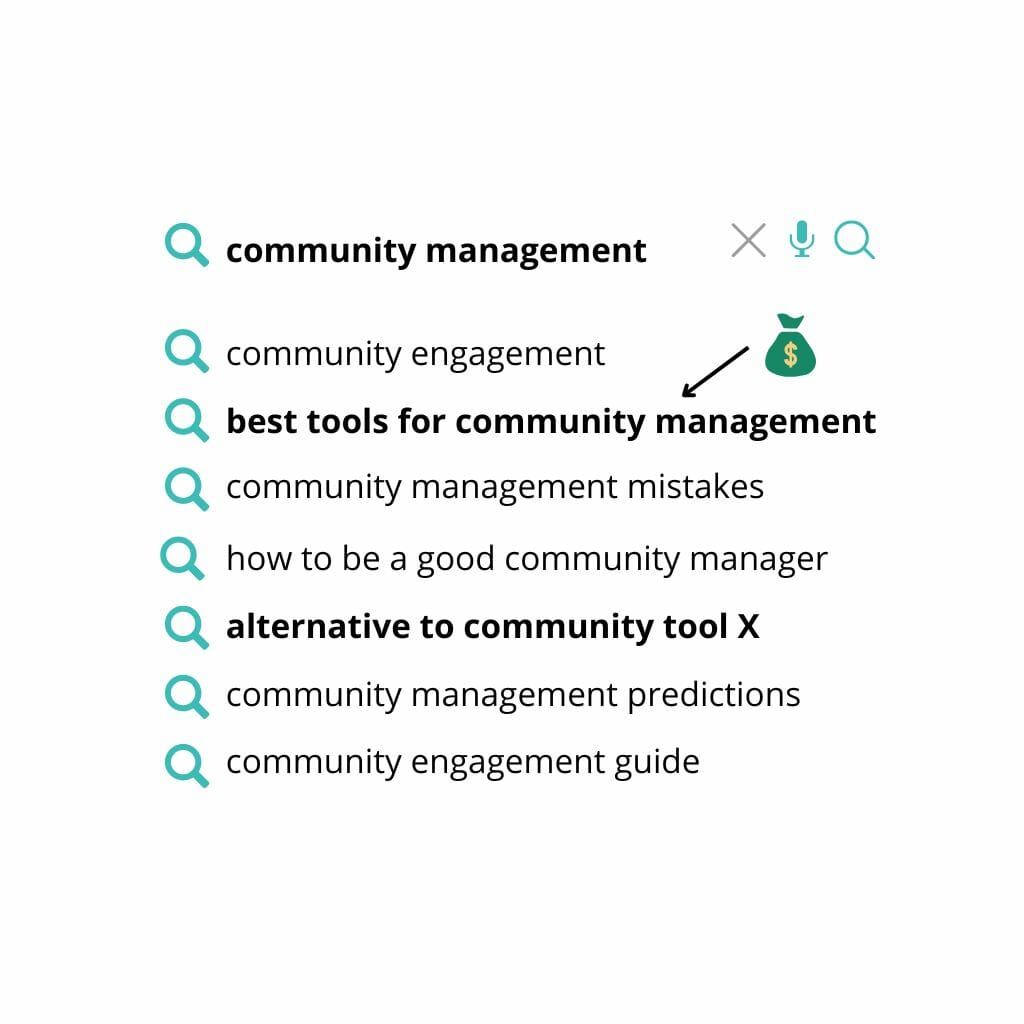
These are not just ordinary keywords. As you might guess, they only have a little keyword volume.
But if you are a pizza restaurant and you would like to make revenue out of SEO, it’d not make much sense to write an article on ”how to make a pizza” or ”pizza recipe”.
Sure, that would bring traffic. But these are keywords that are hard to rank for and do not have any commercial intent.
In other words, they are not money keywords.
Do not get me wrong – you can still create article content for a pizza restaurant.
But the keywords would be around people doing a commercial investigation, such as ”best pizza restaurant in london” or ”best places to eat good lasagna”.
With money keywords, our goal is to focus on the bottom-of-the-funnel keywords.
These are keywords that customers search for when they are already aware of what they are looking for.
In B2C, they are often ”buy”; ”under $20”; ”best”; ”sale”; ”cheap”, where your goal is to capture the demand for people looking to buy.
In B2B, it makes sense to go after ”alternative to X tool” or ”best X tools in the industry’‘, where you position your product or service offering.
Now that we got that clear, let’s now go over different ways you can conduct keyword research.
We will go over both the standard best practices, which include using SEO tools and competitor analysis, as well as more niche ways that tap into our audience for insights.
At the end of the article, I will also share an interesting way of finding profitable keywords.
Standard Keyword Research Process: How To Use SEO Tools Like a Pro
Let’s go over the step-by-step process of finding profitable keywords for your blog that you can realistically rank for and that can produce bottom-line results:
Step 1: Generate seed keywords from your products
The keyword research begins with getting a list of the products and services you are offering.
Let’s take for example a vodka brand. Our seed keywords would be our sub-categories:
- Vodka
- Flavoured Vodka
- Canned Vodka
Note: In this case, we do not own our products as we are a retailer, so this is why we would also take the names of the brands as seed keywords (e.g. ”Smirnoff vodka”).
You can check our 2-step guide on how to find seed topic ideas.
Step 2: Enter seed keywords into a research tool
The next step is to use a Keyword Research Tool that has good keyword exploration features.
Throughout this article, we will use LowFruits to showcase the importance of researching the SERPs while doing keyword research.

We were able to get 3,505 keyword ideas from LowFruits, but this is rather broad. Also, some of them would not be relevant to us. We need some filtering.
This is why we want to open the ‘’Topics’’ filter (I’ve opened it for you in the screenshot above) and then remove some of the categories that appear there.
In our case, we are looking for keywords with a high purchase intent, which is why we can check off cocktail-related topics (e.g., ‘’mule’’ and ‘’espresso’’) as well as nutrition keywords (e.g. ‘’gluten’’ and ‘’percentage’’).
The reason why SEOs love using LowFruits is that it’s also possible to exclude keyword variants during the keyword research process.
This is why, after inputting the seed keyword, it makes sense to go over keywords and queries that you do not want to appear in your research.
I’ll exclude well-known vodka retailers from my keyword analysis. They have a navigational intent, where users know the specific website they want to visit, so excluding them is necessary.

So far so good – we are down to 3071 keywords, but that’s still a very high number of keywords.
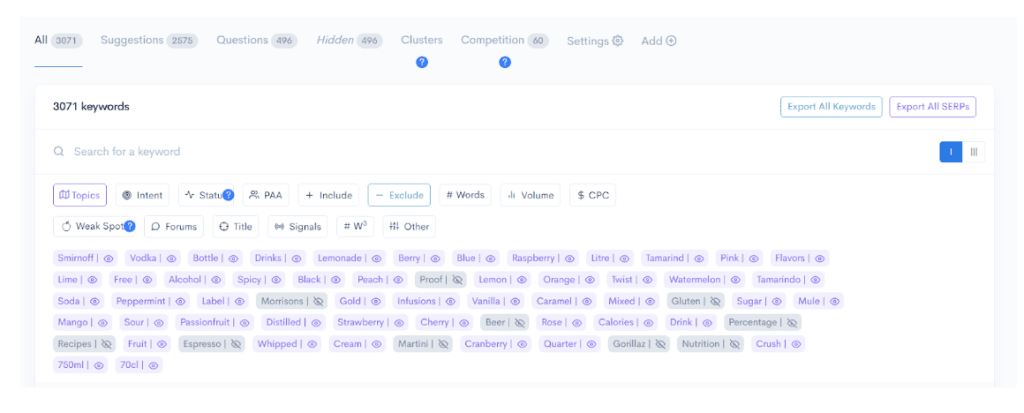
After this step, what matters is what your goal is. If you are looking for content ideas for your blog, you could click on ‘’Questions’’ and see the 496 questions that were generated.
But we are interested in not just any questions – we are interested in high purchase intent keywords.
Step 3: Applying Relevant Filters: Search Intent
As we are looking for profitable keywords, we will apply the following filter:
We set the intent to ‘’Pre-Purchase’’ as this will show us keywords from people who are researching Smirnoff vodka
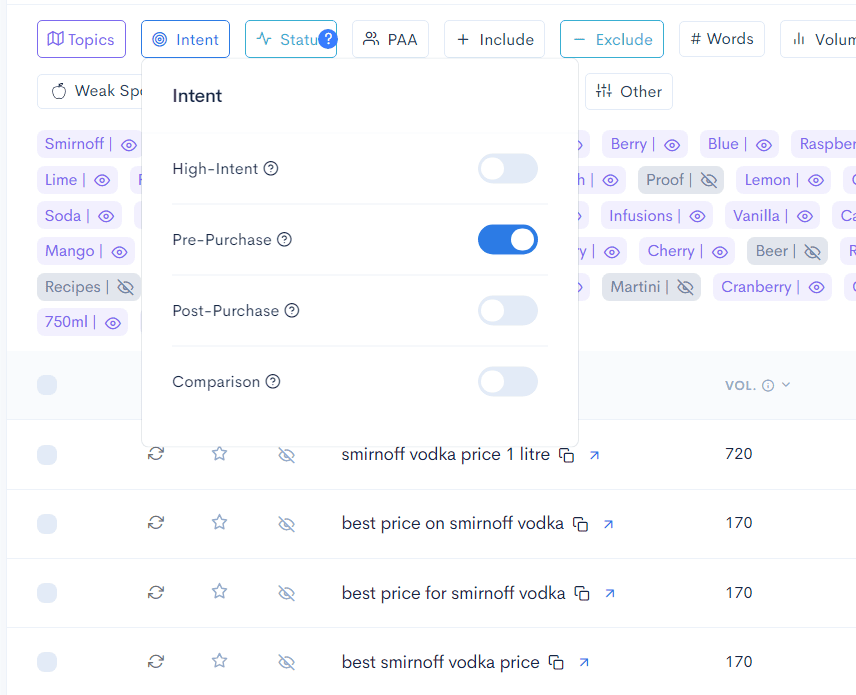
And just like that, we are down to 236 keywords. These are keywords and topics that, if covered and optimized, will bring in qualified customers.
But we also want to check out how strong is the competition for these keywords.
Step 4: Bulk Analyze the SERPs with LowFruits
The reason why SEO professionals use LowFruits is because you can analyze the SERPs in bulk (for every keyword at once) and it will give you a breakdown of what keywords can realistically rank.
These are keywords that will have websites that are ranking which have a low domain authority, or under-optimised forum pages.
In this example, we are going to select our 236 keywords and analyze them to see what keywords our website can realistically rank for.
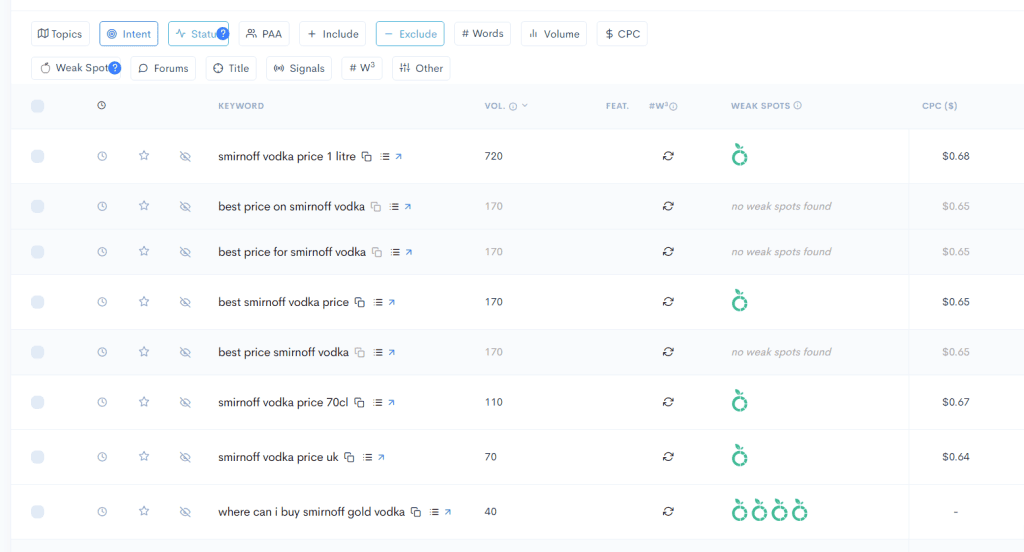
Every green fruit symbolizes a website that ranks on the 1st page for this keyword that has a domain authority of less than 20. In other words, there is a website that is easy to beat.
In the case of ‘’where can i buy smirnoff gold vodka’’, we have 4 fruits, which means there are 4 websites ranking on the 1st page for that keyword that we can beat.
What competitors are considered ‘’easy to beat’’ is also up to you. It’s possible to use your domain’s domain authority (Smirnoff.com has a DA of 61) in order to get a better picture.
With LowFruits you can even take it a step further and filter out by ‘’weak spots’’ in the top 3 results for a keyword. That means there is at least 1 site out of the 3 that rank at the top that you can outrank.
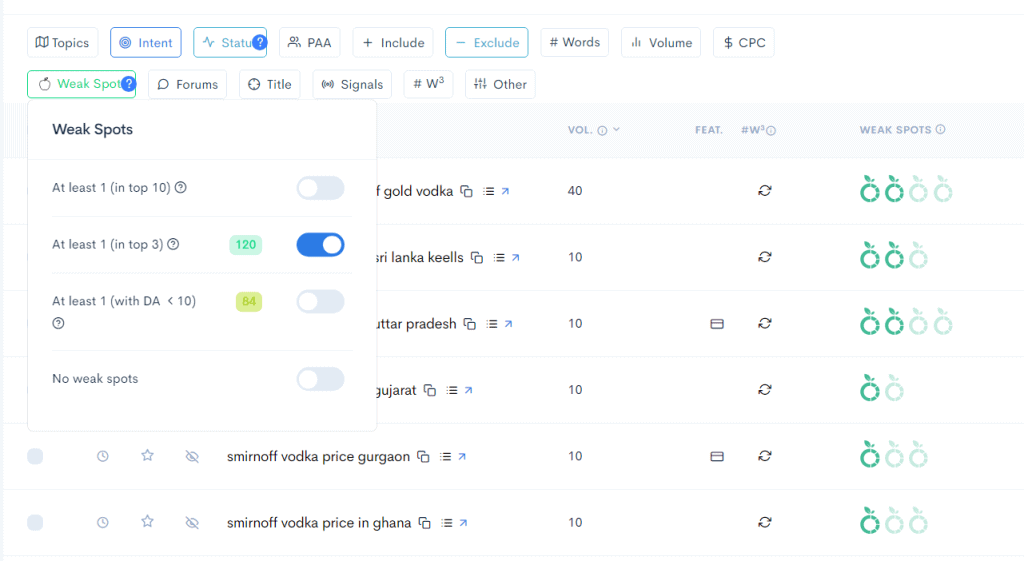
Now we want to export this list, and manually remove keywords that do not make sense for us to go after. These include:
- Competitor names
- Products we do not offer (e.g. ”vodka gift sets”)
- Other industry-specific keywords that you do not want to pursue (e.g., ”smirnoff vodka alternative”)
Pro Tip: When researching “money” keywords, don’t worry too much about monthly search volumes. Even with just 50 monthly searches, there are still 50 potential buyers.
You can check out our guide explaining the value of low search volume keywords.
Step 5: Build Keyword Clusters
Most SEOs stop at the last step, but trust me – this is important.
After manually correcting some keywords, we are left with 110. But these are not 110 separate article ideas, nor 110 separate product pages.
In fact, for these keywords, we would need around 20 pages. And this is why this step is so important.
Otherwise, if we were to create a page for all of these keywords, they would start competing against one another. That’s called keyword cannibalisation.
Our goal is to identify the main keyword groups and then allocate these keywords to specific pages.
Here’s how it would look like in our Smirnoff vodka example:
- cherry vodka
- cherry smirnoff
- cherry flavoured vodka
This keyword group gets allocated to our Smirnoff Cherry Vodka product page.
It’s also important to make the difference between a product page, an article, and a category page when you are allocating the different keywords.
Here’s what it would look like for a Smirnoff category page:
- cheap smirnoff vodka
- smirnoff bottles
- smirnoff price
These are keywords that people want to explore their options. They do not want to buy something specific. This is why it deserves a category page.
The same logic goes for article pages. Let’s look at a vodka cocktail recipe (Moscow Mule):
- moscow mule cocktail recipe
- moscow mule ingredients
- moscow mule step-by-step
Keep in mind that if the keyword was ”smirnoff moscow mule”, that would deserve its own page and its own keyword group, since searchers are looking for a Moscow Mule with Smirnoff.
This process of keyword clustering usually takes a few hours, but in LowFruits we can automatically generate the keyword clusters.
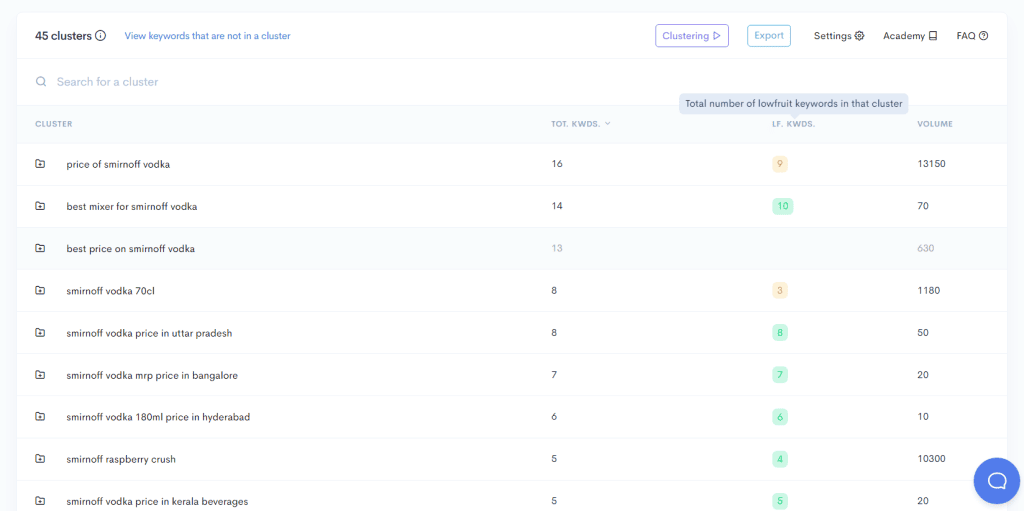
In this report, LowFruits also provides us with the total amount of the fruit keywords that are easy for us to rank for. That will help me prioritize what clusters and keywords to go after first.
This is the standard process of keyword research, but I did promise you that I will walk you through another process, which is concerned with tapping into your customers.
Customer Research for Content Ideas
The keywords that come directly from your own customers can be just as powerful. This is why we are going to tap into our ideal and existing customers.
The first place to look for would be review websites and discussion forums.
For B2B, that would be G2; for B2C, it’s most likely Reddit and Quora.

These platforms are used for a combination of content ideas:
- Competitors to go after
- Problems that your customers have
- What functionality makes these products good
- What people would want more out of these tools
Another way to research your customers is by asking them directly.
You can create a survey of 5-10 questions and then send them out to your existing customers who love your product.
Your goal is to ask them:
- What problems were they struggling with before using your product
- How your product solved it for them
- What’s their favourite functionality of your product or services
- How would they search for your product
Naturally, these questions will vary from brand to brand, but your goal is to understand how people are searching for you and how you are solving their problems.
Here’s an example of a survey that I sent out for a B2B brand:

Here are the keyword ideas that I got from this question alone:
- How to increase the revenue from your community
- How to show the value of community in your organization
- How to segment and profile your community members
- How to track community engagement
These were keywords that we were able to go after that our ideal audience was struggling with.
The queries themselves did not have commercial intent, but we were able to position our product as the solution to these problems.
Key Takeaways: How To Find Profitable Keywords
- There is a difference between normal keywords and profitable keywords – in the search intent of the search.
- Brands should go after keywords that are realistic to rank for and have revenue potential.
- You can use keyword research tools such as LowFruits to conduct extensive keyword research that also has the potential to analyze the SERPs in bulk.
- Begin by thinking about all of your products, services, and offerings and these should be your seed keywords to research.
- Filters in SEO tools allow you to narrow down thousands of keywords into a small but useful list of keywords.
- Build topic clusters and do not forget to properly allocate the keywords to their own URLs, rather than creating content out of every keyword. This process can be automated with tools like LowFruits.
- Just because a keyword has low search volume, does not mean you should ignore it. If it has transactional intent, it means it could be sales that you are leaving on the table.
- Customer research is beneficial; check competitors’ G2 pages, Reddit, and Quora for insights. Surveys work well with satisfied existing customers.